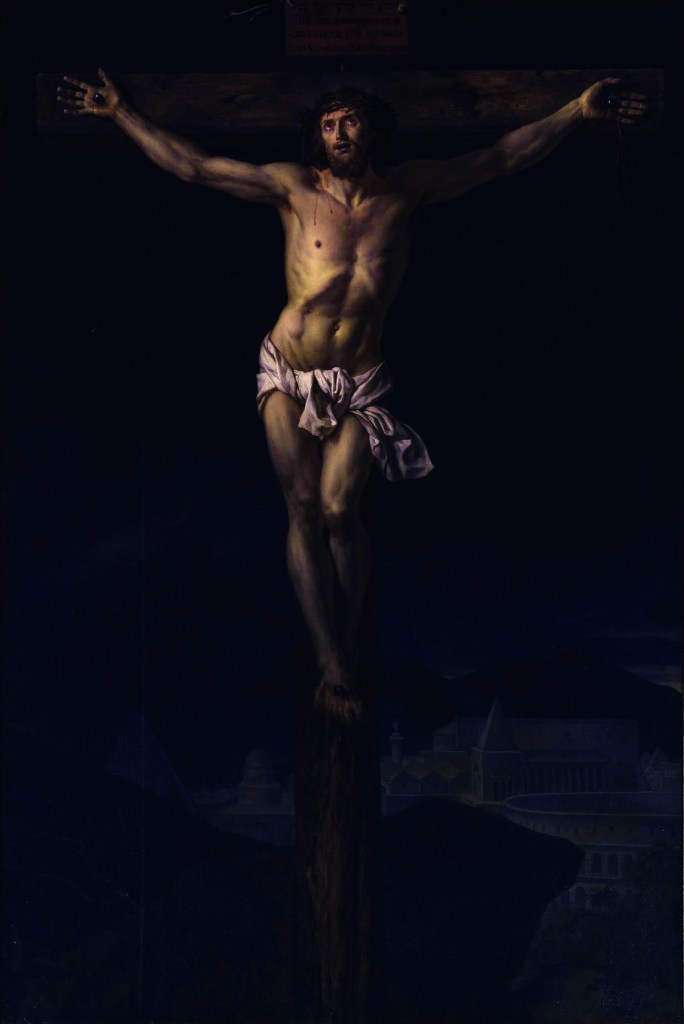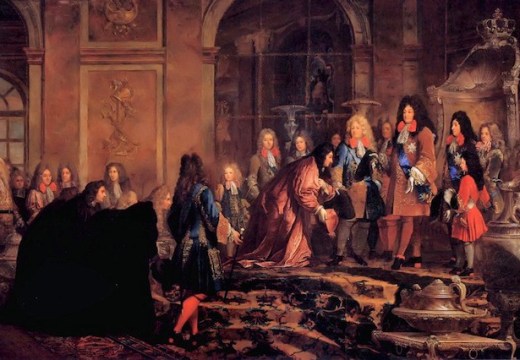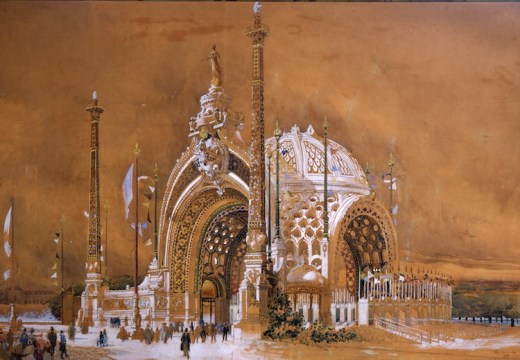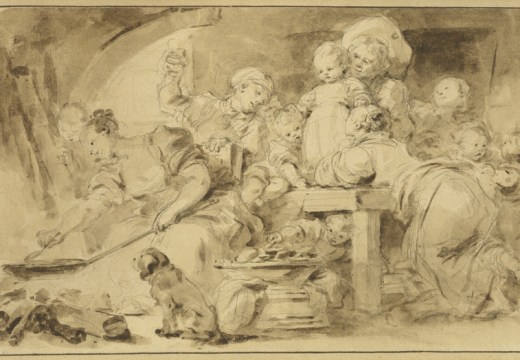The narrative of 18th-century French art traditionally portrays the death of Louis XIV in 1715 as marking the end of the public, state art of the grand siècle and ushering in an art that is usually characterised as aristocratic, secular, and sensual. The era of the Sun King’s l’état c’est moi was followed by the regency (the period 1715 to 1723 when Louis XV was a minor and France was governed by Philippe d’Orléans, Louis XIV’s nephew) during which control of l’état was keenly contested. The creative triumvirate of Charles Le Brun, André Le Nôtre, and Louis Le Vau was long gone (the landscape architect Le Nôtre, the last to go, dying appropriately in 1700) and Paris rather than Versailles had become the centre of power.
The 18th century was, however, about more than rococo jeux d’esprit, the domesticity of Chardin, and the charged intimacy of Watteau, Fragonard and Boucher. The declarative nature of the baroque didn’t disappear, but changed until it re-emerged in the last decades of the century in the serious-mindedness of neoclassicism. Religious art in particular continued, despite the distractions of fêtes galantes and the boudoir. ‘Baroque during the Enlightenment: 18th-Century Masterpieces in Parisian Churches’ at the Petit Palais, shows above all how this often ignored strand of French art has been hiding in plain sight, dispersed around Paris’s innumerable churches .

The Nativity (c. 1730), Nicolas Largillière. Church of Saint-Sulpice. Photo: © Thomas Hennocque
It also shows how a tranche of petites-maîtres – from Carle van Loo and Charles-Antoine Coypel, who are usually associated with portraiture and fancy pictures, to the animalier Jean-Baptiste Oudry and the history and classical painter François Lemoyne – kept religious art as a regular part of their practice. The age of sensibility remained an age of religious sensibility, too, not least because it made sound financial sense: a succession of Louis XIV’s churches came to completion in the first half of the century, among them Saint-Roch, Notre-Dame-des-Victoires and Saint-Sulpice (second only to Notre Dame in size) and later Soufflot’s great church of Sainte-Geneviève, all replete with chapels that needed decorating.
Among the early works in the exhibition are an Adoration of the Magi and a Nativity (both c. 1730) by Nicolas de Largillière, a familiar at Versailles, who, in 1709 had painted Louis XIV and his family. In these two small religious pictures his long years as a portraitist of the aristocracy have left their mark: the Christ child is shown as a dauphin while the Virgin has the features of Louis’s mistress Madame de Maintenon . There is though in each a tenderness entirely in keeping with the Counter-Reformation demands for clear narrative and intense feeling.
The painting where this intensity is at its most striking is in Nicolas-Bernard Lépicié’s depiction of the Calvary Chapel in the church of Saint-Roch (1765; Fig. 1). The chapel was a collaboration between the architect Étienne-Louis Boullée, the sculptor Falconnet, and Lépicié and takes the form of a stygian grotto with massive naturalistic rocks surrounding an altar and above it a sculpted Virgin on her knees at the foot of a crucified Christ. This gesamtkunstwerk no longer exists as Lépicié painted it but the effect, captured in his picture, remains immersive, haunting. and of a type of dramatic illusionism more usually found in Italy than in France.

The Calvary Chapel in the Church of Saint-Roch (1756), Nicolas-Bernard Lépicié. Musée Carnavalet, Paris. Photo: © Musée Carnavalet/Roger Viollet
The picture is an exception, for although the exhibition calls the prevailing style baroque, this is not entirely accurate. There is a lightening of the palette on display (in Van Loo, say), a delight in textures (Gabriel-François Doyen), and a softness (Jean Restout), which are distinctly rococo in feel. It is a very small leap, for example, from the manger Adorations painted by Van Loo and Coypel to the bucolic dalliance pictures of Fragonard and Boucher. Nor is there much of the Enlightenment present as promised by the title, perhaps unsurprisingly given the Encyclopedists’ scepticism towards organised religion.
What is in evidence, however, is a shift away from the contemplative saints as subjects and towards those who had been active in the world – missionaries or founders of institutions that administered relief to the sick and poor. It was a change driven in part by a taste for written lives of the saints, in particular those whose lives were properly attested. It was this that lay behind such works as Paul-Ponce-Antoine Robert’s St Francis Solano Baptising the Indians (1730), Joseph-Ferdinand-François Godefroy’s St Carlo Borromeo giving Communion to the Plague Stricken (c. 1775) and Jean-François de Troy’s St Vincent de Paul Preaching (1730–33). The last is one of 11 paintings from different artists commissioned for the church of the priests of the Mission of Saint-Lazare – a taste for cycles of paintings being another characteristic of the age.
As the century progressed artists began to favour the Old Testament over the New because it fitted better with the developing taste for classical antiquity. In 1783 Hugues Taraval painted the Sacrifice of Noah on Leaving the Ark, an unusual subject and a bravura piece of painting that was not initially intended for a church, but commissioned by the comte d’Angiviller for the royal collection (which perhaps explains the inclusion of gratuitous naked breasts). Other subjects include the Good Samaritan, painted by Nicolas-René Jollain, and the Return of the Prodigal Son by Jean-Germain Drouais – this last a perfect neoclassical composition with its bas-relief format, pared back setting, and classical costumes.

Christ on the Cross (1782), Jacques-Louis David. Cathedral of Saint-Vincent, Macon. Photo: © Eschmann
Drouais was a pupil of the greatest French neoclassicist, Jacques-Louis David, and the highlight of the exhibition is the last of David’s rare forays into religious art: Christ on the Cross (1782), now in the cathedral at Mâcon. The following year, in Rome, he painted The Oath of the Horatii, a statement of his Republicanism and newly minted neoclassical style. Christ, with echoes of Rubens, Caravaggio, and Reni, is shown against a night sky with just enough light left to pick out a capriccio of ancient Rome behind him with the Colosseum and the Pyramid of Cestius prominent. The next time David painted such a body was 10 years later in his posthumous portrait of the Revolutionary leader Marat. By then Robespierre had replaced God – and therefore the whole tradition presented in this thoughtful and revealing exhibition – with the Cult of the Supreme Being. David was to become a close ally of Robespierre; his Christ is not just a painting but an endgame.
‘Baroque during the Enlightenment; 18th Century Masterpieces in Paris Churches’ is at the Petit Palais, Paris until 16 July.
From the June 2017 issue of Apollo: subscribe here.
Unlimited access from just $16 every 3 months
Subscribe to get unlimited and exclusive access to the top art stories, interviews and exhibition reviews.














![Masterpiece [Re]discovery 2022. Photo: Ben Fisher Photography, courtesy of Masterpiece London](http://www.apollo-magazine.com/wp-content/uploads/2022/07/MPL2022_4263.jpg)
Why are fathers so absent from art history?